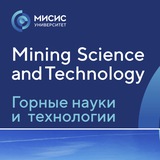We present the articles of the first issue of scientific journal "Mining Science and Technology” (Russia) for 2025:
Scientists conducted laboratory tests according to the International Society for Rock Mechanics (ISRM) methodology to investigate fracture toughness at interfaces between gypsum stone and sand-cement mortar. The fracture toughness coefficient K_IC was determined using cylindrical specimens 40 mm in diameter and 150 mm long with a V-shaped notch, tested in three-point bending. Results showed that the average KIC value for the rock-concrete interface was only 0.323 MPa×√m – 4 times lower than for pure gypsum (1.327 MPa×√m) and 2.5 times lower than for concrete specimens (0.858 MPa×√m). Interestingly, the formation of a calibrated fracture during testing caused a 30% increase in the internal mechanical loss factor Q⁻¹, revealing new possibilities for fracture toughness evaluation using resonance methods. These findings have important practical implications for the design, operation and monitoring of industrial mining facilities containing rock-concrete interfaces.
For more information, see the article:
📌 Voznesenskii А.S., Ushakov E.I., Kutkin Ya.O. Fracture toughness of rock-concrete interfaces and its prediction based on acoustic properties. Mining Science and Technology (Russia). 2025;10(1):5-14. https://doi.org/10.17073/2500-0632-2024-10-316
Subscribe to our Telegram channel:
👉 t.iss.one/MinSciTech 👈
#InEnglish #MST #rocks #concrete #gypsum #flintstone #interface #properties #fracturetoughness #acoustics #study #testing #acousticmeasurements #elasticwaves #velocity #losses #prediction #strain #rockmechanics #geophysics #ISRM #KIC #Qfactor #monitoring #strength #failure #cement #science #technology #RSFgrant #nondestructivetesting #resonancemethod #mining #engineeringsolutions
Scientists conducted laboratory tests according to the International Society for Rock Mechanics (ISRM) methodology to investigate fracture toughness at interfaces between gypsum stone and sand-cement mortar. The fracture toughness coefficient K_IC was determined using cylindrical specimens 40 mm in diameter and 150 mm long with a V-shaped notch, tested in three-point bending. Results showed that the average KIC value for the rock-concrete interface was only 0.323 MPa×√m – 4 times lower than for pure gypsum (1.327 MPa×√m) and 2.5 times lower than for concrete specimens (0.858 MPa×√m). Interestingly, the formation of a calibrated fracture during testing caused a 30% increase in the internal mechanical loss factor Q⁻¹, revealing new possibilities for fracture toughness evaluation using resonance methods. These findings have important practical implications for the design, operation and monitoring of industrial mining facilities containing rock-concrete interfaces.
For more information, see the article:
📌 Voznesenskii А.S., Ushakov E.I., Kutkin Ya.O. Fracture toughness of rock-concrete interfaces and its prediction based on acoustic properties. Mining Science and Technology (Russia). 2025;10(1):5-14. https://doi.org/10.17073/2500-0632-2024-10-316
Subscribe to our Telegram channel:
👉 t.iss.one/MinSciTech 👈
#InEnglish #MST #rocks #concrete #gypsum #flintstone #interface #properties #fracturetoughness #acoustics #study #testing #acousticmeasurements #elasticwaves #velocity #losses #prediction #strain #rockmechanics #geophysics #ISRM #KIC #Qfactor #monitoring #strength #failure #cement #science #technology #RSFgrant #nondestructivetesting #resonancemethod #mining #engineeringsolutions
👍2⚡1❤1👏1🙏1💯1
🔍 Dry vs wet: unexpected results for Arkachan gold ore
Comparison Methods:
✔️ Dry Processing: Crushing (DKD-300) + Grinding (TsMVU-800) + Pneumatic Separation (POS-2000)
✔️ Wet Processing: Gravity Separation with GRG Test (ITOMAK-0.1)
📊 Key Data:
Gold Distribution:
✔️ 27.35% in -0.2+0.1 mm class;
✔️ 11.75% in -0.1+0.071 mm class;
✔️ 23.46% in -0.071 mm class;
→ Total 62.56% in particles <0.2 mm
Method Efficiency:
✔️ pneumatic Separation: 35.25% recovery at 1.8 t/h;
✔️ GRG Test: 73.91% recovery with grinding to 80% passing 0.071 mm.
GRG Test Results by Stage:
✔️ Stage 1 (-1 mm): 40.20% recovery;
✔️ Stage 2 (-0.315 mm): +14.46%;
✔️ Stage 3 (-0.071 mm): +20.88%.
Conclusions:
1. Dry methods are ineffective for fine-grained gold (<100 µm).
2. Gravity separation requires fine grinding but achieves high recovery.
3. Major losses are due to incomplete liberation of gold in pyrite.
🔗 Full Article:
Matveev А.I., Lebedev I.F., Vinokurov V.R., Lvov E.S. Comparative processing studies of the Arkachan deposit gold-bearing ores using dry separation and classical wet gravity separation methods. Mining Science and Technology (Russia). 2024;9(2):158-169. https://doi.org/10.17073/2500-0632-2023-10-168
🔔 Subscribe: @MinSciTech
💬 What modern methods could improve dry processing for such ores?
#InEnglish #MST #Mining #Gold #Beneficiation #Crusher #Mill #Separator #DryProcessing #ParticleSize #Pyrite #Sample #Ore #Test #Method #Analysis #Stage #Class #Gravity #FineGrained #Particles #Concentrate #Grinding #Efficiency #Crushing #Recovery #Flowchart #Cycle #Fraction #Balance #Parameter #Mode #Degree #Impact #Abrasion #Subsample #Sludge #Pulp #SizeFraction #Feed #Tailings #Losses #Product #Intergrowths
P.S. For ores with fine-grained gold, classical gravity remains optimal. Are there alternatives?
Comparison Methods:
✔️ Dry Processing: Crushing (DKD-300) + Grinding (TsMVU-800) + Pneumatic Separation (POS-2000)
✔️ Wet Processing: Gravity Separation with GRG Test (ITOMAK-0.1)
📊 Key Data:
Gold Distribution:
✔️ 27.35% in -0.2+0.1 mm class;
✔️ 11.75% in -0.1+0.071 mm class;
✔️ 23.46% in -0.071 mm class;
→ Total 62.56% in particles <0.2 mm
Method Efficiency:
✔️ pneumatic Separation: 35.25% recovery at 1.8 t/h;
✔️ GRG Test: 73.91% recovery with grinding to 80% passing 0.071 mm.
GRG Test Results by Stage:
✔️ Stage 1 (-1 mm): 40.20% recovery;
✔️ Stage 2 (-0.315 mm): +14.46%;
✔️ Stage 3 (-0.071 mm): +20.88%.
Conclusions:
1. Dry methods are ineffective for fine-grained gold (<100 µm).
2. Gravity separation requires fine grinding but achieves high recovery.
3. Major losses are due to incomplete liberation of gold in pyrite.
🔗 Full Article:
Matveev А.I., Lebedev I.F., Vinokurov V.R., Lvov E.S. Comparative processing studies of the Arkachan deposit gold-bearing ores using dry separation and classical wet gravity separation methods. Mining Science and Technology (Russia). 2024;9(2):158-169. https://doi.org/10.17073/2500-0632-2023-10-168
🔔 Subscribe: @MinSciTech
💬 What modern methods could improve dry processing for such ores?
#InEnglish #MST #Mining #Gold #Beneficiation #Crusher #Mill #Separator #DryProcessing #ParticleSize #Pyrite #Sample #Ore #Test #Method #Analysis #Stage #Class #Gravity #FineGrained #Particles #Concentrate #Grinding #Efficiency #Crushing #Recovery #Flowchart #Cycle #Fraction #Balance #Parameter #Mode #Degree #Impact #Abrasion #Subsample #Sludge #Pulp #SizeFraction #Feed #Tailings #Losses #Product #Intergrowths
P.S. For ores with fine-grained gold, classical gravity remains optimal. Are there alternatives?
👍4❤2🔥1🙏1💯1
